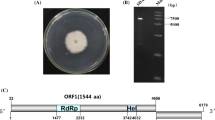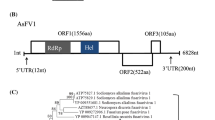Abstract
Here, a novel mycovirus, tentatively designated as “Botryosphaeria dothidea fusarivirus 2” (BdFV2), was discovered in Botryosphaeria dothidea strain JZ-3. The complete genome sequence is 6,271 nucleotides (nt) in length, excluding the poly(A) tail, and contains two putative open reading frames (ORFs). The larger ORF1 encodes a polypeptide of 1,552 amino acids (aa) with conserved RNA-dependent RNA polymerase (RdRp) domains and a viral helicase domain. The ORF1-encoded polypeptide shares 19.47–78.70% sequence identity with those of other fusariviruses and shares the highest sequence identity (78.70%) with the corresponding protein aa sequences of Neofusicoccum luteum fusarivirus 1 (NlFV1) isolate CBS110299. The small ORF2 encodes a hypothetical protein with 479 aa, which is predicted to contain a chromosome segregation protein SMC domain of unknown function. Sequence alignments and phylogenetic analysis indicated that BdFV2 is a distinct member of the recently established family Fusariviridae. BdFV2 appears to be a novel fusarivirus infecting a pathogenic B. dothidea strain that causes pear ring rot disease.


Similar content being viewed by others
References
Marzano SL, Nelson BD, Ajayi-Oyetunde O, Bradley CA, Hughes TJ, Hartman GL, Eastburn DM, Domier LL (2016) Identification of diverse mycoviruses through metatranscriptomics characterization of the viromes of five major fungal plant pathogens. J Virol 90:6846–6863
Ghabrial SA, Caston JR, Jiang D, Nibert ML, Suzuki N (2015) 50-plus years of fungal viruses. Virology 479–480:356–368
Kotta-Loizou I, Coutts RHA (2017) Studies on the virome of the entomopathogenic fungus Beauveria bassiana reveal novel dsRNA elements and mild hypervirulence. PloS Pathog 13:e1006183
Li X, Sui K, Xie J, Hai D, Yin W, Sossah FL, Jiang D, Song B, Li Y (2020) Molecular characterization of a novel fusarivirus infecting the edible fungus Auricularia heimuer. Arch Virol 165:2689–2693
Yu X, Li B, Fu Y, Jiang D, Ghabrial SA, Li G, Peng Y, Xie J, Cheng J, Huang J, Yi X (2010) A geminivirus-related DNA mycovirus that confers hypovirulence to a plant pathogenic fungus. Proc Natl Acad Sci U S A 107:8387–8392
Liu L, Xie J, Cheng J, Fu Y, Li G, Yi X, Jiang D (2014) Fungal negative-stranded RNA virus that is related to bornaviruses and nyaviruses. Proc Natl Acad Sci U S A 111:12205–12210
Zhong J, Shang HH, Zhu CX, Zhu JZ, Zhu HJ, Hu Y, Gao BD (2016) Characterization of a novel single-stranded RNA virus, closely related to fusariviruses, infecting the plant pathogenic fungus Alternaria brassicicola. Virus Res 217:1–7
Picarelli M, Forgia M, Rivas EB, Nerva L, Chiapello M, Turina M, Colariccio A (2019) Extreme diversity of mycoviruses present in isolates of Rhizoctonia solani AG2-2 LP from Zoysia japonica from Brazil. Front Cell Infect Microbiol 9:244
Chu YM, Jeon JJ, Yea SJ, Kim YH, Yun SH, Lee YW, Kim KH (2002) Double-stranded RNA mycovirus from Fusarium graminearum. Appl Environ Microbiol 68:2529–2534
Marsberg A, Kemler M, Jami F, Nagel JH, Postma-Smidt A, Naidoo S, Wingfield MJ, Crous PW, Spatafora JW, Hesse CN, Robbertse B, Slippers B (2017) Botryosphaeria dothidea: a latent pathogen of global importance to woody plant health. Mol Plant Pathol 18:477–488
Tang W, Ding Z, Zhou ZQ, Wang YZ, Guo LY (2012) Phylogenetic and pathogenic analyses show that the causal agent of apple ring rot in China is Botryosphaeria dothidea. Plant Dis 96:486–496
Zhai L, Zhang M, Lv G, Chen X, Jia N, Hong N, Wang G (2014) Biological and molecular characterization of four Botryosphaeria species isolated from pear plants showing stem wart and stem canker in China. Plant Dis 98:716–726
Yu X, Li B, Fu Y, Jiang D, Ghabrial SA, Li G, Peng Y, Xie J, Cheng J, Huang J (2010) A Geminivirus-related DNA mycovirus that confers hypovirulence to a plant pathogenic fungus. Proc Natl Acad Sci USA 107:8387–8392
Yang M, Xu W, Zhou X, Yang Z, Wang Y, Xiao F, Guo Y, Hong N, Wang G (2021) Discovery and characterization of a novel bipartite Botrexvirus from the phytopathogenic fungus Botryosphaeria dothidea. Front Microbiol 12:696125
Wang L, Jiang J, Wang Y, Hong N, Zhang F, Xu W, Wang G (2014) Hypovirulence of the phytopathogenic fungus Botryosphaeria dothidea: association with a coinfecting chrysovirus and a partitivirus. J Virol 88:7517–7527
Zhai L, Xiang J, Zhang M, Fu M, Yang Z, Hong N, Wang G (2016) Characterization of a novel double-stranded RNA mycovirus conferring hypovirulence from the phytopathogenic fungus Botryosphaeria dothidea. Virology 493:75–85
Zhai L, Yang M, Zhang M, Hong N, Wang G (2019) Characterization of a botybirnavirus conferring hypovirulence in the phytopathogenic fungus Botryosphaeria dothidea. Viruses 11:266
Liu H, Wang H, Zhou Q (2021) A novel mycovirus isolated from the plant-pathogenic fungus Botryosphaeria dothidea. Arch Virol 166:1267–1272
Yang M, Zhou X, Zhai L, Xiao F, Hong N, Wang G (2020) Molecular characterization of a novel mycovirus infecting the phytopathogenic fungus Botryosphaeria dothidea. Arch Virol 165:1667–1670
Liu W, Hai D, Mu F, Yu X, Zhao Y, He B, Xie J, Jiang D, Liu H (2020) Molecular characterization of a novel fusarivirus infecting the plant-pathogenic fungus Botryosphaeria dothidea. Arch Virol 165:1033–1037
Lian Z, Das S, Luo J, Andika IB, Sun L (2021) Complete genome sequence of a novel ourmia-like mycovirus infecting the phytopathogenic fungus Botryosphaeria dothidea. Arch Virol 166:3461–3465
Liu H, Liu M, Zhu H, Zhong J, Liao X, Zhou Q (2021) Molecular characterization of a novel mitovirus from the plant pathogenic fungus Botryosphaeria dothidea. Arch Virol 166:633–637
Wang H, Liu H, Lu X, Wang Y, Zhou Q (2021) A novel mitovirus isolated from the phytopathogenic fungus Botryosphaeria dothidea. Arch Virol 166:1507–1511
Zou Q, Gao Y, Wang Q, Yang Y, Wang F, Hong N, Wang G, Wang L (2021) The full-length genome sequence of a novel mitovirus from Botryosphaeria dothidea, the causal agent of pear ring rot disease. Arch Virol 166:2881–2885
Zhai L, Hong N, Zhang M, Wang G (2015) Complete dsRNA sequence of a novel victorivirus isolated from the pear stem wart fungus Botryosphaeria dothidea. Arch Virol 160:613–616
Yang M, Zhai L, Xiao F, Guo Y, Fu M, Hong N, Wang G (2019) Characterization of a novel victorivirus isolated from the phytopathogenic fungus Botryosphaeria dothidea. Arch Virol 164:1609–1617
Wang Y, Zhao H, Cao J, Yin X, Guo Y, Guo L, Wu H, Zhang M (2022) Characterization of a novel mycovirus from the phytopathogenic fungus Botryosphaeria dothidea. Viruses 14:331
Marais A, Nivault A, Faure C, Comont G, Theil S, Candresse T, Corio-Costet MF (2018) Molecular characterization of a novel fusarivirus infecting the plant-pathogenic fungus Neofusicoccum luteum. Arch Virol 163:559–562
Choi YG, Randles JW (1997) Microgranular cellulose improves dsRNA recovery from plant nucleic acid extracts. Biotechniques 23:610–611
Liu H, Fu Y, Jiang D, Li G, Xie J, Peng Y, Yi X, Ghabrial SA (2009) A novel mycovirus that is related to the human pathogen hepatitis E virus and rubi-like viruses. J Virol 83:1981–1991
Nicholas KB (1997) GeneDoc: analysis and visualization of genetic variation. Embnew News 4:14
Kumar S, Stecher G, Tamura K (2016) MEGA7: molecular evolutionary genetics analysis version 7.0 for bigger datasets. Mol Biol Evol 33:1870–1874
Funding
This research was supported by the National Natural Science Foundation of China (31972321, 31471862), the Earmarked Fund for Pear Modern Agro-industry Technology Research System (CARS-28-16).
Author information
Authors and Affiliations
Corresponding author
Ethics declarations
Conflict of interest
All authors declare that they do not have any conflict of interest regarding this article.
Ethical approval
This article does not contain any experiments with human participants or animals performed by any of the authors.
Additional information
Handling Editor: Ioly Kotta-Loizou.
Publisher’s Note
Springer Nature remains neutral with regard to jurisdictional claims in published maps and institutional affiliations.
Electronic Supplementary Material
Below is the link to the electronic supplementary material
Rights and permissions
About this article
Cite this article
He, Y., Zou, Q., Li, S. et al. Molecular characterization of a new fusarivirus infecting Botryosphaeria dothidea, the causal agent of pear ring rot disease. Arch Virol 167, 1893–1897 (2022). https://doi.org/10.1007/s00705-022-05492-w
Received:
Accepted:
Published:
Issue Date:
DOI: https://doi.org/10.1007/s00705-022-05492-w




